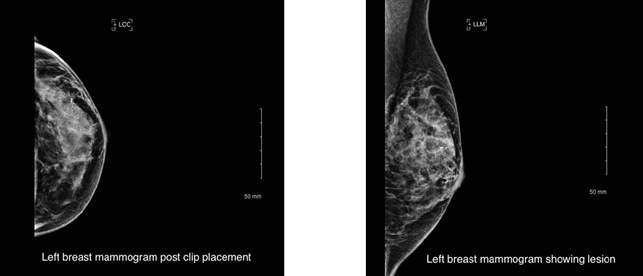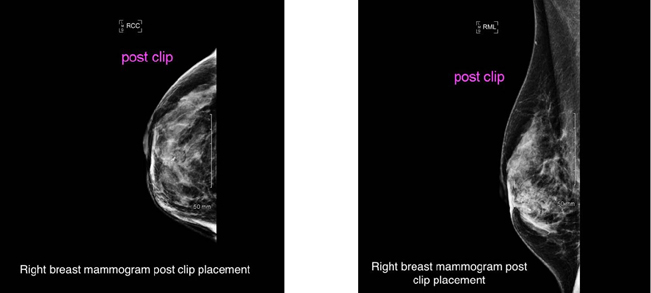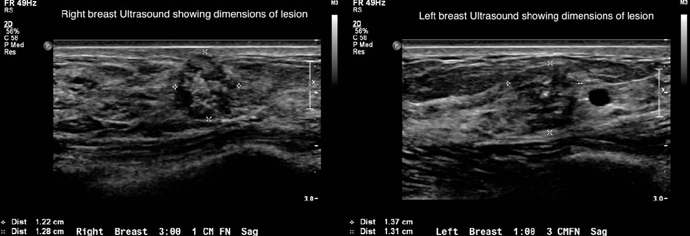Abstract
Despite advances made in conventional oncological treatment for early-stage breast cancer, it can still cause severe side effects without curative guarantee. To this date, acupuncture has proven beneficial for palliative purposes and treatment of chemotherapy-related toxicities only. We present a case of a female patient who refused standardized medical care and decided to pursue acupuncture with therapeutic objectives with encouraging outcomes. This favorable result gives way to the idea of potentially studying this modality in well-designed trials for the treatment of early stage breast cancer on its own.
Key words
breast cancer, acupuncture, moxibustion, alternative medicine, palliative care
Introduction
Although the mechanism of action of acupuncture remains unclear, its benefit for wellness and treatment of several diseases has been acknowledged. Its popularity has progressively increased reaching an all time high over the last few years. In cancer, acupuncture has consistently proven capable of better management of chemotherapy and radiotherapy-related side effects in multiple types of cancer. Methodological limitations and inconclusive or contradictory results have prevented its integration to conventional oncological treatment or its use as complementary medicine. Moreover, little has been investigated regarding its benefits in palliative population and even as alternative medicine for cancer treatment. We present a case of a 56yo female diagnosed with triple positive invasive left ductal carcinoma and simultaneous right in-situ ductal carcinoma who declined conventional oncological treatment and pursued acupuncture treatment with inspiring results.
Case description
A 56yo G0P0 female with no significant past medical history presented with bilateral abnormal screening mammogram. Her past surgical history was significant for a right excisional biopsy in 1991 that showed atypical cells but did not follow any therapy option. Her family history was positive for early stage breast cancer when her mother was in her 70s and a maternal cousin who underwent mastectomy for this in her 40s. Gynecological history was relevant for menarche at age 15, menopause at age 50, and she had never used any contraceptive methods. Her mammogram reported “grouped heterogeneous calcifications in the right subareolar breast at 3 o’clock and left breast 1 o’clock. There are mass-like areas associated with the calcifications”. Subsequent ultrasound reported “poorly defined mass in the right breast at 3 o’clock with associated calcifications which corresponds to the mammography finding. The area measures 1.6 x 1.2 x 1.3 cm. There is a similar area in the left breast 1 o’clock which measures 1.7 x 1.4 x 1.3 cm”. US guided biopsy demonstrated right ductal carcinoma-in-situ, intermediate nuclear grade, and cribriform pattern with comedal necrosis and associated calcifications, ER + (90%)”. Left breast tissue demonstrated “invasive ductal carcinoma, histologic grade 2, with ductal carcinoma-in-situ, low nuclear grade, cribriform patterns with focal necrosis, ER + (95%), PR + (75%) with usual ductal hyperplasia, columnar cell change, sclerosing adenosis and cysts calcifications associated with invasive tumor, ductal carcinoma in-situ, lobules and stroma". Given her staging (left T1sN0 DCIS, intermediate nuclear grade and a right T1cNo IDC, grade 2, ER +, PR +), she was recommended bilateral wide local excision and bilateral sentinel lymph node biopsy with genetic counseling. However patient refused conventional oncological treatment despite several warnings and decided to pursue acupuncture treatment as an alternative treatment modality (Figures 1 and 2).

Figure 1. Left breast mammogram post clip placement
Left breast mammogram showing lesion

Figure 2. Right breast mammogram post clip placement
At the time of initial presentation for acupuncture treatment, patient complained of insomnia, night sweats, sinus problems, mouth sores and nocturia. Initial evaluation showed an exhausted, irritated patient with obvious stress and anxiety. The right breast lump was measured at 3 cm2 and completely adjacent to the nipple, and the left one was soft and measured 4 cm2. Treatment plan was designed to prevent Qi stasis of stomach and Liver meridians as well as to hopefully eliminate the lump(s). The acupuncture points used were as following: GB21 Jian Jing, ST16 Yingchuang, LI11 Quchi, ST 36 Zusanli, RN4 (CV4) Guan Yuan, GB36 WaiQiu, LR9 (LV9) YinBao, GB37 Guang Ming, GB39 XuanZhong, Upper back surface bloodletting. A week after initial therapy, patient reported feeling stronger and better. Insomnia was improving and night sweats had completely subsided. The right breast mass was no longer fixed. However pulse was soft and slow; and tongue had a light thin cover. Treatment was planned at that time to eliminate cold inside, promote Qi flow and to eliminate the lump. Patient was seen 19 days after with no significant change in lump characteristics appreciated although stomach was now hot and there was stasis of Liver Qi. Seven days after this visit, wet accumulation was noted. After 3 months treatment, CA27.29 was 16.5 ng/mL (0.0-38.0). During acupuncture treatment, patient performed self moxibustion on a daily basis and drank Ling Zhi soap (Ganoderma Lucidum Karst). Three month followup visit revealed complete resolution of symptoms and no perceivable masses on physical examination. A repeat ultrasound performed at this time indicated no perceivable masses. At this time patient had received treatment twice a week for 6 weeks followed by weekly sessions for another 6 week period (Figure 3).

Figure 3. Right and Left breast Ultrasound showing dimensions of lesion.
Discussion
Acupuncture is becoming an important component of complementary and alternative medicine techniques used in oncological population [1]. With a small needle inserted in certain areas of the body, pain is relieved and the body’s healing is facilitated. Its real mechanism of action remains unclear. Based on current evidence and knowledge, the possible answers that have been proposed are included in the biological computer model among others. This proposes that the human body mimics a biological computer where organs are the headquarters and the body surface is the keyboard. Both of them are wired through proposed meridians. When a body is alive, a keyboard can be used to send instructions through twelve meridians and other Jing/Lou (additional channels) to organs initiating an action. Another possible theory, the connective tissue stretch theory, derives from similar conclusions. According to this hypothesis, the mysterious acupuncture meridians may also be related to connective tissue, as they appear to be preferentially located along connective-tissue planes between muscles and/or bones. Supporters affirm that more than 80 percent of acupuncture points in the arm are located along connective-tissue planes. Acupuncture-needle manipulation of this connective tissue results in sustained stretching and therefore constitutes a useful tool that can be used to study the acupuncture biomechanical function. A twisted acupuncture needle creates a localized stretch by gripping the underlying connective tissue. This effect can be observed as a “tenting” of the skin as the needle is pulled out and a visceral response is elicited [2]. On the other side, some believe that acupuncture manipulation of certain points can induce an ATP-production increase. Once released, ATP will act as a transmitter that binds to purinergic receptors, including P2X and P2Y receptors. ATP cannot be transported back into the cell but is rapidly degraded to adenosine by several ectonucleotidases before re-uptake. Thus, adenosine acts as an analgesic agent that suppresses pain through Gi-coupled A1-adenosine receptors. This has been encompassed into “ATP/ADP transition model” [3]. Finally, the Physics Quark particular-string theory. This latter one unveils an explanation of supersymmetry of particles by string correlation. Any force acts on a particular quark to induce a similar movement in peer quarks in unlimited distance. Since string theory incorporates all of the fundamental interactions, including gravity, many physicists hope that it fully describes our universe, making it a theory of everything. Current research in string theory is focused in finding a solution that is quantitatively identical with the standard model, along with a small cosmological constant, containing dark matter and a plausible mechanism for cosmic inflation. Particular Quark is found to fit string theory which has been described as peer particular linked with string in unlimited distances.
However, although its real scientific mechanism of action and role in mortality benefit for breast cancer remains to be determined, it is well established that acupuncture can contribute to better management of chemotherapy-induced side effects such as nausea and vomiting [4]. Additionally, fatigue, anxiety, physical distress, emotional distress, poor quality of life and odontological pain can be mitigated with such practices [5]. Also, appetite increase and weight loss slowing was seen in patients with gastrointestinal and thyroid cancers using acupuncture as complementary medicine [6]. Controversially, several authors have argued that there is not enough evidence for acupuncture and/or acupressure to be used as regular complementary or alternative treatment, although others have accounted it as an important modality in palliative care [7,8]. This is even more supported by the fact that unwanted side effects related to these techniques are only limited to minimal bleeding and mild pain on the insertion site. Published case reports have demonstrated successful outcomes of acupuncture treatment of uterine myoma in terms of tumor size reduction [9]. In breast cancer, acupuncture has been proven to improve aromatase inhibitor-related musculoskeletal symptoms [10]. However, little is known regarding its impact when used for therapeutic purposes as complementary or even as alternative treatment options.
Moxibustion was believed to be capable of providing benefits for patients with cancer, ulcerative colitis, stroke rehabilitation, constipation, hypertension, pain conditions and breech presentation. Moxibustion dates back to the 16th century. Artemisia, or mugworth is an herb used to produce “Moxa” (jiǔ (灸) or jiǔshù (灸術). This is used to warm meridian points in the body with the intention of stimulating circulation and inducing a smoother Qi. Some authors insist in its capacity to treat conditions associated with the "cold" or "yang deficiencies”. Bian Que, the first specialist in moxibustion, discussed the benefits of moxa over acupuncture in Bian Que Neijing by affirming that moxa could add energy to the body and could treat not only deficient conditions but also “excesses”. As such, if cancer patient feels weak or in in “cold”, moxibustion treatment may provide a beneficial effect. Inversely, moxibustion has not proven capable of providing even symptomatic relief to patients with breast cancer. Although some believe moxibustion is capable of treating cancer-related fatigue, immune function and pain, high risk of bias and low reporting quality of the studies do not allow for statistically significant difference to be drawn [11-14].
Our patient declined treatment with conventional oncological treatment and decided to attempt curative acupuncture and moxibustion. Following a course focused in strengthening Qi flowing and eliminating lump in Stomach, Larger Intestine, Gallbladder and Liver meridians acupuncture treatment up to twice a week for a 3 month period and self moxibustion with Ling Zhi soap, breast cancer progression stopped. Follow up ultrasound actually revealed disappearance of both breast masses. Even more so, tumor markers were measured to be within normal limits further supporting the theory that acupuncture with moxibustion can be sufficient by themselves to treat and control early stage triple positive breast invasive ductal carcinoma and carcinoma in-situ.
Conclusion
Acupuncture has proven to be useful as an adjunct treatment for cancer or chemotherapy or radiotherapy-induced symptom management. While high-quality trials are still needed to establish the treatment's efficacy, palliative patients may benefit from these primarily safe, low-cost services. Furthermore, acupuncture has become an important tool as a complementary instrument in the treatment of conventional oncologic treatment-induced side effects. Our case report argues that this treatment modality might also be sufficient by itself to treat triple positive breast invasive ductal carcinoma and carcinoma in-situ breast cancer in early stages. More standardized studies will be of course necessary for these practices to become an individual treatment option for patients with early stage breast cancer as conventional oncological treatment remains unsurpassed when it comes to proven safety and efficacy.
References
- Menendez A, Said Calvino A, Espat J (2015) Patient Reported Experience Combining Complementary and Alternative Medicine (CAM) with Conventional Oncology Treatment (COT)”. J Clin Oncol 33.
- The Science of Stretch (2013) The study of connective tissue is shedding light on pain and providing new explanations for alternative medicine. By Helene M. Langevin, May 1, 2013 Scientist.
- Burnstock G (2009) Acupuncture: a novel hypothesis for the involvement of purinergic signaling. Med Hypotheses 73: 470-2. [Crossref]
- Thompson LM, Osian SR, Jacobsen PB, Johnstone PA (2015) Patient-reported Outcomes of Acupuncture for Symptom Control in Cancer. J Acupunct Meridian Stud 8: 127-133. [Crossref]
- MacPherson H, Thomas K, Walters S, Fitter M (2001) The York acupuncture safety study: prospective survey of 34 000 treatments by traditional acupuncturists. BMJ 323: 486-487. [Crossref]
2021 Copyright OAT. All rights reserv
- Yoon SL, Grundmann O, Williams JJ, Carriere G (2015) Novel intervention with acupuncture for anorexia and cachexia in patients with gastrointestinal tract cancers: a feasibility study. Oncol Nurs Forum 42: E102-109. [Crossref]
- Pan CX, Morrison RS, Ness J, Fugh-Berman A, Leipzig RM (2000) Complementary and alternative medicine in the management of pain, dyspnea, and nausea and vomiting near the end of life. A systematic review. J Pain Symptom Manage 20: 374-387. [Crossref]
- Standish LJ, Kozak L, Congdon S (2008) Acupuncture is underutilized in hospice and palliative medicine. Am J Hosp Palliat Care 25: 298-308. [Crossref]
- Habek D, Akšamija A (2014) Successful acupuncture treatment of uterine myoma. Acta Clin Croat 53: 487-489. [Crossref]
- Chien TJ, Liu CY, Chang YF, Fang CJ, Hsu CH (2015) Acupuncture for treating aromatase inhibitor-related arthralgia in breast cancer: a systematic review and meta-analysis. J Altern Complement Med 21: 251-260. [Crossref]
- Lee S, Jerng UM, Liu Y, Kang JW, Nam D, et al. (2014) The effectiveness and safety of moxibustion for treating cancer-related fatigue: a systematic review and meta-analyses. Support Care Cancer 22: 1429-1440. [Crossref]
- Zhang SY, Du YQ (2011) [Effects of warming needle moxibustion on improvement of gastrointestinal and immune function in patients with postoperation of colorectal cancer]. Zhongguo Zhen Jiu 31: 513-517. [Crossref]
- Lee J, Yoon SW (2013) Efficacy and Safety of Moxibustion for Relieving Pain in Patients With Metastatic Cancer: A Pilot, Randomized, Single-Blind, Sham-Controlled Trial. Integr Cancer Ther 13: 211-216. [Crossref]
- Menendez A, Luo LG (2015) Breast Cancer – Review of Complementary and Alternative Medicine (CAM) and Traditional Chinese Medicine (TCM) Approach. Int J Complement Alt Med 1: 00013.



